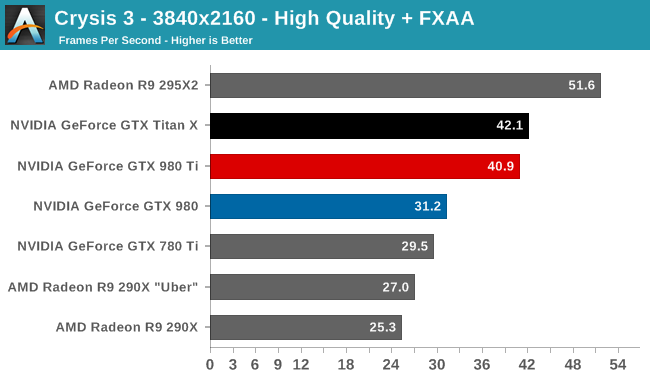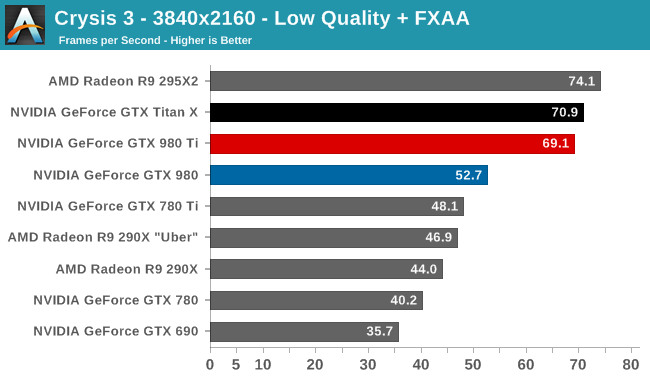The NVIDIA GeForce GTX 980 Ti Review
by Ryan Smith on May 31, 2015 6:00 PM ESTCrysis 3
Still one of our most punishing benchmarks, Crysis 3 needs no introduction. With Crysis 3, Crytek has gone back to trying to kill computers and still holds “most punishing shooter” title in our benchmark suite. Only in a handful of setups can we even run Crysis 3 at its highest (Very High) settings, and that’s still without AA. Crysis 1 was an excellent template for the kind of performance required to drive games for the next few years, and Crysis 3 looks to be much the same for 2015.



Once more we find the GTX 980 Ti and GTX Titan X virtually tied. Across all settings and resolutions the GTX 980 Ti stays within 97-98% of the Titan’s performance. Consequently GTX Titan X is ever so marginally better, but not enough to make any real difference.
This also means that GTX 980 Ti continues with its very strong lead over the GTX 980. Once more we’re looking at a 26-31% performance advantage for the latest member of the GTX 900 series, in-line with its price premium.
Meanwhile on an absolute basis, as one of our most punishing games this is also a good reminder of why even GM200 cards can’t quite pull off high quality 4K gaming with a single GPU today. Even without MSAA and one step below Crysis 3’s Very High quality settings, the GTX 980 Ti can only muster 40.9fps. If you want to get to 60fps you will need to drop to Low quality, or drop the resolution to 1440p. The latter will get you 83.2fps at the same quality settings, which again highlights GTX 980 Ti’s second strength as a good card for driving high refresh rate 1440p displays.










290 Comments
View All Comments
FlushedBubblyJock - Wednesday, June 10, 2015 - link
I bought a bunch of G80 G92 G92b and G94 nvidia cards because you could purchase memory size, bandwidth, bit width, power connector config, essentially any speed at any price point for a gamers rig, install the same driver, change the cards easily, upgrade for your customers without hassles...IT WAS A GOLD MINE OF FLEXIBILITY
What happened was, the amd fanboys got very angry over the IMMENSE SUCCESS of the initial G80 and it's reworked cores and totally fluid memory, card size, bit width, and pricing configurations... so they HAD TO TRY TO BRING IT DOWN...
Thus AMD launched their PR war, and the clueless amd fan launched their endless lies.
I'll tell you this much, no on would trade me a 9800GTX for a 9800GT
I couldn't get the 92 bit width cards for the same price as the 128 bit
DDR2 and DDR3 also differentiated the stack massively.
What we had wasn't rebranding, but an amazingly flexible GPU core that stood roaring above at the top and could be CUT down to the middle and the low gaming end, an configured successfully with loads of different bit widths and memory configs....
64 bit width, 92, 128, 256, 384, 192, ETC...
That was an is a awesome core, period.
BillyONeal - Sunday, May 31, 2015 - link
And people have been bent out of shape about it. For "YEARS" :)dragonsqrrl - Sunday, May 31, 2015 - link
Their highest-end rebadge, the 390X, will likely compete with the 980, not the 980 Ti. The 980 Ti will be closer to Fiji's performance profile.austinsguitar - Sunday, May 31, 2015 - link
I dont think you realize how much more efficiant this card is even compared to past cards for its nm and performance. This is a feat. Just calm down and enjoy. I am very happy that the cards price us perfect. :) thanks nvidiaMapRef41N93W - Sunday, May 31, 2015 - link
Maybe you aren't aware of how silicon works, but this a 601mm^2 die which costs a boat load to produce especially with the rising costs of crystalline silicon dies. Being on 28nm this long just means the yields are higher (which is why a 601mm^2 is even possible).You aren't going to see a 14nm card that outperforms this by much till 2017 at the earliest which following the recent NVIDIA trends should see the Titan XYZ (whatever they want to call it) which should be a pretty huge jump at a pretty high price.
Thomas_K - Monday, June 1, 2015 - link
Actually AMD is doing 14nm starting next yearhttp://www.guru3d.com/news-story/it-is-official-am...
"Although this was a rumor for a long time now we now know that AMD skips 20nm and jumps onto a 14nm fabrication node for their 2016 GPUs."
dragonsqrrl - Sunday, May 31, 2015 - link
Not sure I understand your comment, 28nm is precisely why we're paying this much for this level of performance in 2015... But it's also pretty impressive for the same reason.Azix - Sunday, May 31, 2015 - link
14/16nm might cost more. 28nm should have better yields and lower cost. These chips do not cost much to make at all (retail price could be 2-3 times the chip cost)dragonsqrrl - Sunday, May 31, 2015 - link
I think you misinterpreted my comment. I was responding to someone who seemed shocked by the fact that price/performance ratios aren't improving dramatically despite the fact that we're on a very mature process. In response I said the fact that we're on the same process is precisely why we aren't seeing dramatic improvements in price/performance ratios."28nm should have better yields and lower cost. These chips do not cost much to make at all (retail price could be 2-3 times the chip cost)"
Yields are just one part of the equation. Die size also plays a significant role in manufacturing costs. The fact that your trying to say with a straight face that GM200 does not cost much to make says more than your written comment itself.
zepi - Monday, June 1, 2015 - link
Assuming perfect scaling 600mm2 28nm chip would shrink to 150mm2 at 14nm.GM107 is a 148mm2 chip, so basically this "monster" with just a dieshrink would find a nice place for itself at the bottom end of Nvidias lineup with after transition to 14nm.
This does not take into account the fact that at 14nm and 150mm2 they couldn't give it enough memory bandwidth so easily, but just tells you something about how significant the reduction in size and manifacturing cost is after the initial ramp-up of the yields.